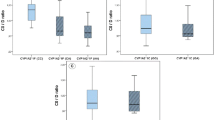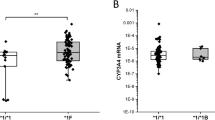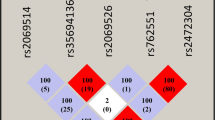Abstract
Clozapine is an atypical antipsychotic metabolized by CYP1A2, CYP2D6, and CYP2C19 enzymes. Among 66 adult schizophrenia patients treated with clozapine-based combination therapies, we explored the impact of genotype-predicted CYP1A2, CYP2D6, and CYP2C19 activity on dose-adjusted clozapine concentrations and symptom severity, with and without correction for inhibitors and inducers of these enzymes. Uncorrected activity scores were not associated with dose-adjusted clozapine concentrations or symptom severity. CYP1A2 and CYP2D6 activity scores corrected for known inducers (i.e., smoking) and inhibitors (e.g., concomitant medications) were associated with dose-adjusted clozapine levels and in the case of CYP1A2, symptom severity. However, smoking status and certain inhibitors of clozapine metabolism (i.e., esomeprazole) explained significantly more variance in dose-adjusted clozapine levels relative to corrected activity scores. These findings highlight the clinical importance of nongenetic factors (smoking, concomitant medications) and suggest that the added utility of CYP1A2, CYP2D6, and CYP2C19 activity scores to guide clozapine dosing is currently limited.
This is a preview of subscription content, access via your institution
Access options
Subscribe to this journal
Receive 6 print issues and online access
$259.00 per year
only $43.17 per issue
Buy this article
- Purchase on Springer Link
- Instant access to full article PDF
Prices may be subject to local taxes which are calculated during checkout





Similar content being viewed by others
References
Pantelis C, Lambert TJ. Managing patients with “treatment-resistant” schizophrenia. Med J Aust. 2003;178:S62–6.
Andreasen NC, Carpenter WT Jr., Kane JM, Lasser RA, Marder SR, Weinberger DR. Remission in schizophrenia: proposed criteria and rationale for consensus. Am J Psychiatry. 2005;162:441–9.
Warnez S, Alessi-Severini S. Clozapine: a review of clinical practice guidelines and prescribing trends. BMC Psychiatry. 2014;14:102.
Spina E, Avenoso A, Facciola G, Scordo MG, Ancione M, Madia AG, et al. Relationship between plasma concentrations of clozapine and norclozapine and therapeutic response in patients with schizophrenia resistant to conventional neuroleptics. Psychopharmacol (Berl). 2000;148:83–9.
Freudenreich O, McEvoy J Guidelines for prescribing clozapine in schizophrenia. Waltham, MA 2018.
Piwowarska J, Radziwon-Zaleska M, Dmochowska M, Szepietowska E, Matsumoto H, Sygitowicz G, et al. The usefulness of monitored therapy using Clozapine concentration in the blood serum for determining drug dose in Polish schizophrenic patients. Pharm Rep. 2016;68:1120–5.
Hiemke C, Bergemann N, Clement HW, Conca A, Deckert J, Domschke K, et al. Consensus guidelines for therapeutic drug monitoring in neuropsychopharmacology: update 2017. Pharmacopsychiatry. 2018;51:9–62.
Dragovic S, Gunness P, Ingelman-Sundberg M, Vermeulen NP, Commandeur JN. Characterization of human cytochrome P450s involved in the bioactivation of clozapine. Drug Metab Dispos. 2013;41:651–8.
Jaquenoud Sirot E, Knezevic B, Morena GP, Harenberg S, Oneda B, Crettol S, et al. ABCB1 and cytochrome P450 polymorphisms: clinical pharmacogenetics of clozapine. J Clin Psychopharmacol. 2009;29:319–26.
Brennan MD. Pharmacogenetics of second-generation antipsychotics. Pharmacogenomics. 2014;15:869–84.
Lee ST, Ryu S, Kim SR, Kim MJ, Kim S, Kim JW, et al. Association study of 27 annotated genes for clozapine pharmacogenetics: validation of preexisting studies and identification of a new candidate gene, ABCB1, for treatment response. J Clin Psychopharmacol. 2012;32:441–8.
Pouget JG, Shams TA, Tiwari AK, Muller DJ. Pharmacogenetics and outcome with antipsychotic drugs. Dialogues Clin Neurosci. 2014;16:555–66.
Preskorn SH, Kane CP, Lobello K, Nichols AI, Fayyad R, Buckley G, et al. Cytochrome P450 2D6 phenoconversion is common in patients being treated for depression: implications for personalized medicine. J Clin Psychiatry. 2013;74:614–21.
Shah RR, Smith RL. Addressing phenoconversion: the Achilles’ heel of personalized medicine. Br J Clin Pharm. 2015;79:222–40.
Mostafa S, Kirkpatrick CMJ, Byron K, Sheffield L An analysis of allele, genotype and phenotype frequencies, actionable pharmacogenomic (PGx) variants and phenoconversion in 5408 Australian patients genotyped for CYP2D6, CYP2C19, CYP2C9 and VKORC1 genes. J Neural Transm (Vienna). 2018;8–15.
Seppala NH, Leinonen EV, Lehtonen ML, Kivisto KT. Clozapine serum concentrations are lower in smoking than in non-smoking schizophrenic patients. Pharm Toxicol. 1999;85:244–6.
Meyer JM. Individual changes in clozapine levels after smoking cessation: results and a predictive model. J Clin Psychopharmacol. 2001;21:569–74.
Barnes TRE, Paton C. Antipsychotic polypharmacy in schizophrenia. CNS Drugs. 2011;25:383–99.
First MB, Spitzer RL, Gibbon M, Williams JBW. Structured clinical interview for DSM-IV axis I disorders, clinician version (SCID-CV). Washington, D.C.: American Psychiatric Press, Inc; 1996.
Sheehan DV, Lecrubier Y, Sheehan KH, Amorim P, Janavs J, Weiller E, et al. The mini-international neuropsychiatric interview (M.I.N.I.): the development and validation of a structured diagnostic psychiatric interview for DSM-IV and ICD-10. J Clin Psychiatry. 1998;59(Suppl 20):22–33. quiz 4-57
Kay SR, Fiszbein A, Opler LA. The positive and negative syndrome scale (PANSS) for schizophrenia. Schizophr Bull. 1987;13:261–76.
World Medical Association. World Medical Association Declaration of Helsinki: ethical principles for medical research involving human subjects. JAMA. 2013;310:2191–4.
Mostaid MS, Lee TT, Chana G, Sundram S, Shannon Weickert C, Pantelis C, et al. Elevated peripheral expression of neuregulin-1 (NRG1) mRNA isoforms in clozapine-treated schizophrenia patients. Transl Psychiatry. 2017;7:1280.
Enoch MA, Shen PH, Xu K, Hodgkinson C, Goldman D. Using ancestry-informative markers to define populations and detect population stratification. J Psychopharmacol. 2006;20(4 Suppl):19–26.
Gaedigk A, Simon SD, Pearce RE, Bradford LD, Kennedy MJ, Leeder JS. The CYP2D6 activity score: translating genotype information into a qualitative measure of phenotype. Clin Pharm Ther. 2008;83:234–42.
Hicks JK, Swen JJ, Gaedigk A. Challenges in CYP2D6 phenotype assignment from genotype data: a critical assessment and call for standardization. Curr Drug Metab. 2014;15:218–32.
Mrazek DA, Biernacka JM, O’Kane DJ, Black JL, Cunningham JM, Drews MS, et al. CYP2C19 variation and citalopram response. Pharmacogenet Genomics. 2011;21:1–9.
Saiz-Rodríguez M, Ochoa D, Belmonte C, Román M, Vieira de Lara D, Zubiaur P, et al. Polymorphisms in CYP1A2, CYP2C9 and ABCB1 affect agomelatine pharmacokinetics. J Psychopharmacol. 2019;33:522–31.
Jeppesen U, Gram LF, Vistisen K, Loft S, Poulsen HE, Brøsen K. Dose-dependent inhibition of CYP1A2, CYP2C19 and CYP2D6 by citalopram, fluoxetine, fluvoxamine and paroxetine. Eur J Clin Pharm. 1996;51:73–8.
Harvey AT, Preskorn SH. Fluoxetine pharmacokinetics and effect on CYP2C19 in young and elderly volunteers. J Clin Psychopharmacol. 2001;21:161–6.
Preskorn SH, Greenblatt DJ, Flockhart D, Luo Y, Perloff ES, Harmatz JS, et al. Comparison of duloxetine, escitalopram, and sertraline effects on cytochrome P450 2D6 function in healthy volunteers. J Clin Psychopharmacol. 2007;27:28–34.
Klieber M, Oberacher H, Hofstaetter S, Beer B, Neururer M, Amann A, et al. CYP2C19 phenoconversion by routinely prescribed proton pump inhibitors omeprazole and esomeprazole: clinical implications for personalized medicine. J Pharm Exp Ther. 2015;354:426–30.
Hägg S, Spigset O, Dahlqvist R. Influence of gender and oral contraceptives on CYP2D6 and CYP2C19 activity in healthy volunteers. Br J Clin Pharm. 2001;51:169–73.
Dobrinas M, Cornuz J, Oneda B, Kohler Serra M, Puhl M, Eap CB. Impact of smoking, smoking cessation, and genetic polymorphisms on CYP1A2 activity and inducibility. Clin Pharm Ther. 2011;90:117–25.
Benjamini Y, Hochberg Y. Controlling the false discovery rate: a practical and powerful approach to multiple testing. J R Stat SocietySeries B (Methodol). 1995;57:289–300.
Jamovi. The jamovi project. Version 0.9. Jamovi. https://www.jamovi.org; 2019.
Excoffier L, Lischer HE. Arlequin suite ver 3.5: a new series of programs to perform population genetics analyses under Linux and Windows. Mol Ecol Resour. 2010;10:564–7.
Vasudev K, Choi YH, Norman R, Kim RB, Schwarz UI. Genetic determinants of clozapine-induced metabolic side effects. Can J Psychiatry. 2017;62:138–49.
Wiciński M, Węclewicz MM, Miętkiewicz M, Malinowski B, Grześk E, Klonowska J. Potential mechanisms of hematological adverse drug reactions in patients receiving clozapine in combination with proton pump inhibitors. J Psychiatr Pract. 2017;23:114–20.
van Veggel M, Olofinjana O, Davies G, Taylor D. Clozapine and gastro-oesophageal reflux disease (GORD) - an investigation of temporal association. Acta Psychiatr Scand. 2013;127:69–77.
Piatkov I, Caetano D, Assur Y, Lau SL, Coelho M, Jones T, et al. CYP2C19*17 protects against metabolic complications of clozapine treatment. World J Biol Psychiatry. 2017;18:521–7.
Diaz FJ, Eap CB, Ansermot N, Crettol S, Spina E, de Leon J. Can valproic acid be an inducer of clozapine metabolism? Pharmacopsychiatry. 2014;47:89–96.
Finley P, Warner D. Potential impact of valproic acid therapy on clozapine disposition. Biol Psychiatry. 1994;36:487–8.
Longo LP, Salzman C. Valproic acid effects on serum concentrations of clozapine and norclozapine. Am J Psychiatry. 1995;152:650.
Rostami-Hodjegan A, Amin AM, Spencer EP, Lennard MS, Tucker GT, Flanagan RJ. Influence of dose, cigarette smoking, age, sex, and metabolic activity on plasma clozapine concentrations: a predictive model and nomograms to aid clozapine dose adjustment and to assess compliance in individual patients. J Clin Psychopharmacol. 2004;24:70–8.
Couchman L, Morgan PE, Spencer EP, Flanagan RJ. Plasma clozapine, norclozapine, and the clozapine:norclozapine ratio in relation to prescribed dose and other factors: data from a therapeutic drug monitoring service, 1993-2007. Ther Drug Monit. 2010;32:438–47.
Acknowledgements
The authors wish to acknowledge the Cooperative Research Centre (CRC) Scientific Advisory Committee, in addition to the contributions of study participants, clinicians at recruitment services, staff at the Murdoch Children’s Research Institute, staff at the Australian Imaging, Biomarkers and Lifestyle Flagship Study of Aging, and research staff at the Melbourne Neuropsychiatry Centre, including coordinators Phassouliotis, C., Merritt, A., and research assistants, Burnside, A., Cross, H., Gale, S., and Tahtalian, S. Participants for this study were sourced, in part, through the Australian Schizophrenia Research Bank (ASRB), which is supported by the National Health and Medical Research Council of Australia (Enabling Grant N. 386500), the Pratt Foundation, Ramsay Health Care, the Viertel Charitable Foundation and the Schizophrenia Research Institute. The authors acknowledge the financial support of The CRC programme, an Australian Government Initiative. DL was supported by the J.N. Peters Postdoctoral Fellowship awarded by the University of Melbourne. CP was supported by an NHMRC Senior Principal Research Fellowship (1105825), and a Brain and Behavior Research Foundation (NARSAD) Distinguished Investigator Award. CAB was supported by an NHMRC Career Development Fellowship (1127700), The University of Calgary Cumming School of Medicine, and the Alberta Children’s Hospital Foundation. None of the funding sources played any role in the study design; collection, analysis or interpretation of data; in the writing of the report; or in the decision to submit the paper for publication.
Author information
Authors and Affiliations
Corresponding author
Ethics declarations
Conflict of interest
SM is an employee of myDNA Inc., a company that provides pharmacogenetic testing. CP has participated on Advisory Boards for Janssen-Cilag, Astra-Zeneca, Lundbeck, and Servier. He has received honoraria for talks presented at educational meetings organized by Astra-Zeneca, Janssen-Cilag, Eli-Lilly, Pfizer, Lundbeck, and Shire. CAB is a member of Clinical Pharmacogenetics Implementation Consortium and the Genetic Testing Committee of the International Society of Psychiatric Genetics. He has also received material support from Assurex, CNSDose, Genomind, and AB-Biotics for research purposes and has ongoing research collaborations with MyDNA but does not have equity, stocks, or options in these companies or any other pharmacogenetic companies. The other authors of this manuscript have no relevant disclosures.
Additional information
Publisher’s note Springer Nature remains neutral with regard to jurisdictional claims in published maps and institutional affiliations.
Supplementary information
Rights and permissions
About this article
Cite this article
Lesche, D., Mostafa, S., Everall, I. et al. Impact of CYP1A2, CYP2C19, and CYP2D6 genotype- and phenoconversion-predicted enzyme activity on clozapine exposure and symptom severity. Pharmacogenomics J 20, 192–201 (2020). https://doi.org/10.1038/s41397-019-0108-y
Received:
Revised:
Accepted:
Published:
Issue Date:
DOI: https://doi.org/10.1038/s41397-019-0108-y
This article is cited by
-
Polygenetic risk scores and phenotypic constellations of obsessive–compulsive disorder in clozapine-treated schizophrenia
European Archives of Psychiatry and Clinical Neuroscience (2024)
-
CYP1A2 expression rather than genotype is associated with olanzapine concentration in psychiatric patients
Scientific Reports (2023)
-
Mediation and longitudinal analysis to interpret the association between clozapine pharmacokinetics, pharmacogenomics, and absolute neutrophil count
Schizophrenia (2023)
-
Effect of CYP2D6 pharmacogenetic phenotype and phenoconversion on serum concentrations of antidepressants and antipsychotics: a retrospective cohort study
International Journal of Clinical Pharmacy (2023)
-
Barriers to genetic testing in clinical psychiatry and ways to overcome them: from clinicians’ attitudes to sociocultural differences between patients across the globe
Translational Psychiatry (2022)



